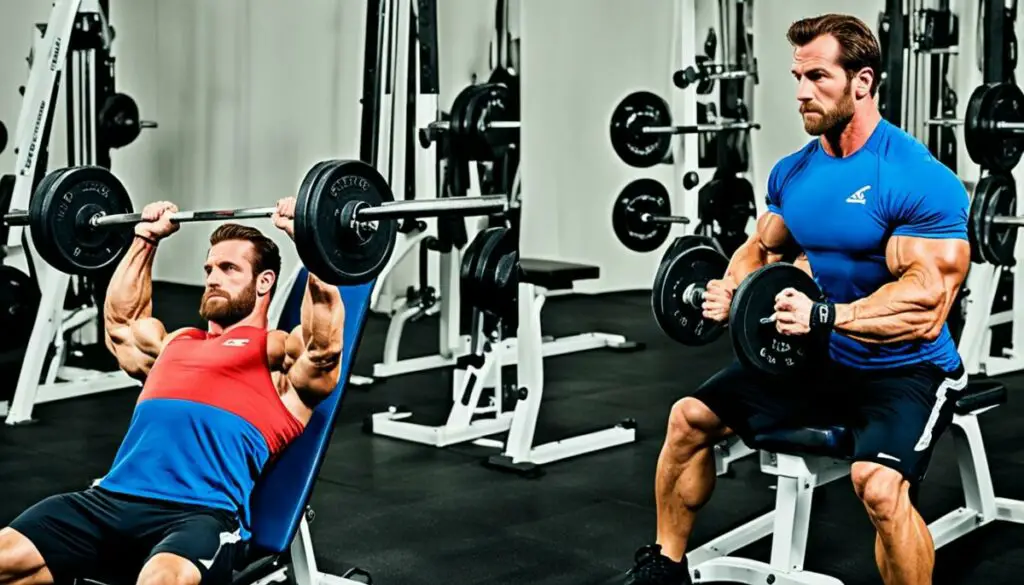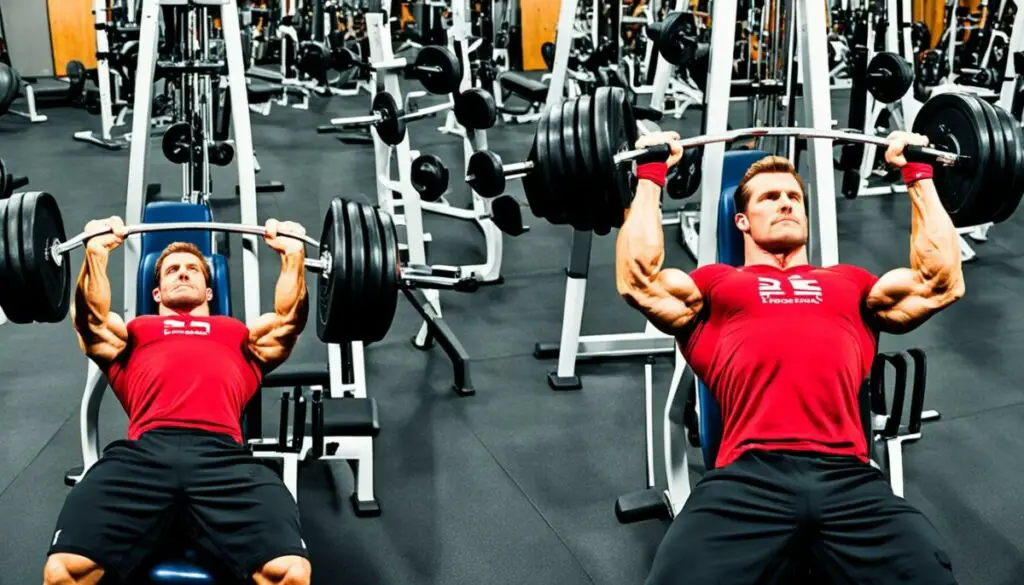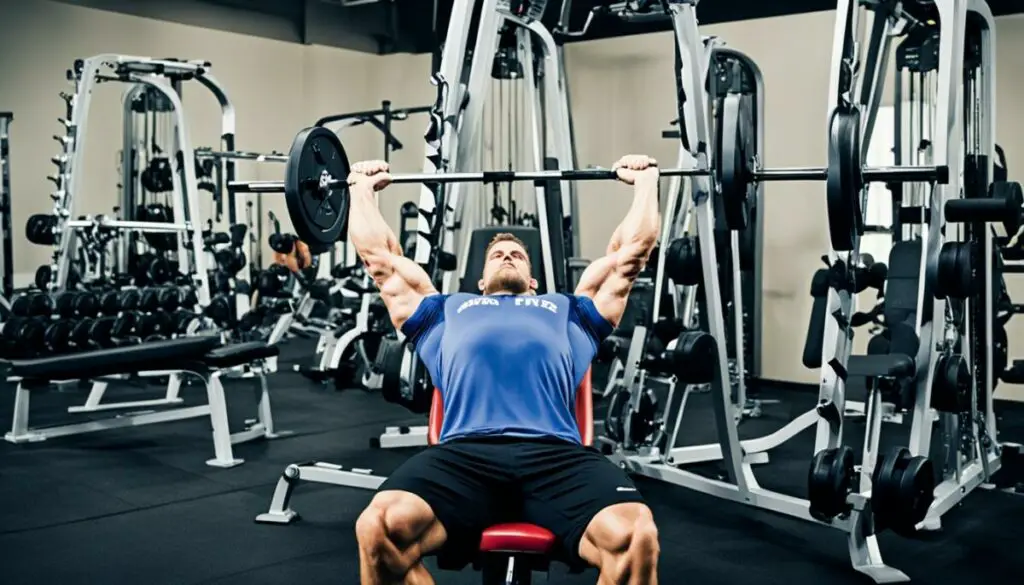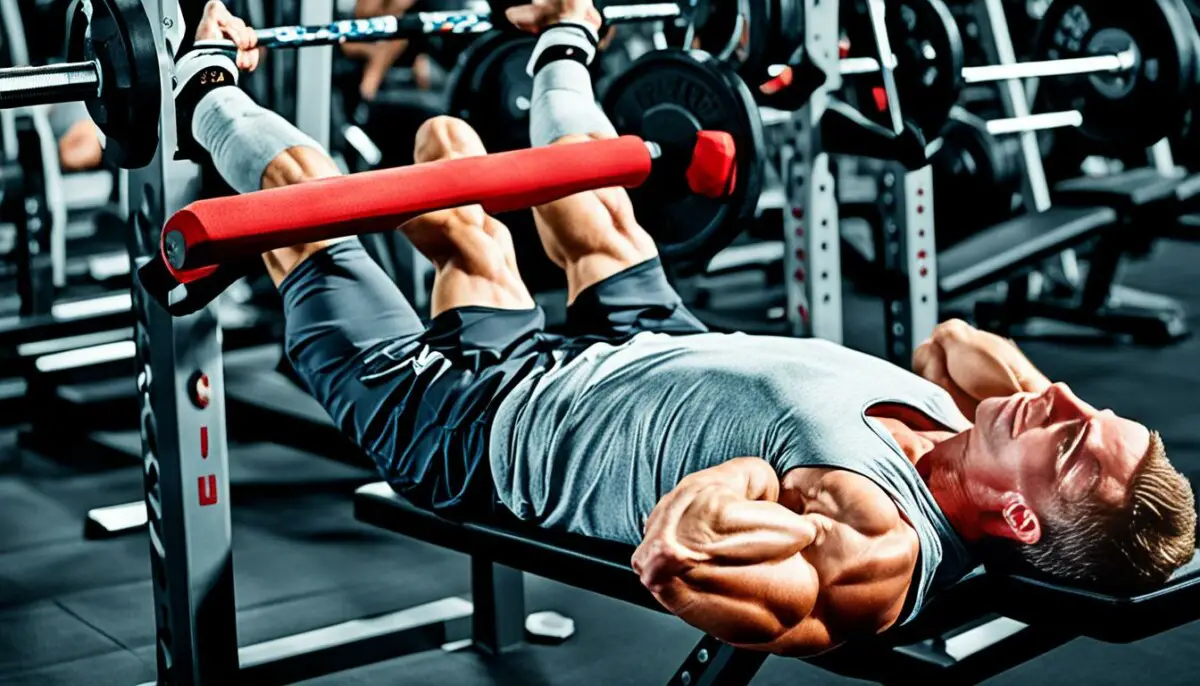Last Updated on 3 months by Francis
The chest-supported row is a highly effective exercise for building back and bicep muscles while providing support to your chest. It is an ideal addition to any upper body workout routine. Whether you are a beginner or a seasoned lifter, incorporating the chest-supported row into your fitness regimen can help you achieve your desired results.
This exercise is particularly advantageous for beginners as it allows them to learn how to engage their muscles without straining their spine. By providing extra support to your chest, the chest-supported row enables you to maintain proper form and isolate the targeted muscles in your back.
To perform the chest-supported row, you will need dumbbells and an adjustable weight bench. By following the correct technique and incorporating variations, you can maximize the efficacy of this exercise and enhance your overall upper body strength.
Contents
Key Takeaways:
- The chest-supported row is a beneficial exercise for building back and bicep muscles.
- It provides extra support to your chest, allowing for proper form and muscle isolation.
- Using dumbbells and an adjustable weight bench, you can perform the chest-supported row effectively.
- There are several variations and alternatives available to target different muscle groups.
- Incorporating the chest-supported row into your workout routine can enhance your upper body strength and posture.
How to Do the Chest-Supported Row

To perform the chest-supported row, follow these steps:
- Set the weight bench to a 45-degree incline.
- Lie chest-down on the bench with dumbbells in hand, palms facing each other.
- Press your toes into the floor and squeeze your glutes and abs for stability.
- Retract your shoulder blades and pull your elbows up toward the ceiling, keeping your upper arms close to your torso.
- Slowly lower the weights back down, maintaining tension in your muscles throughout the exercise.
Performing the chest-supported row with proper form ensures maximum engagement of your back and bicep muscles. Pay attention to your posture and focus on pulling the weights with controlled movements. This exercise is particularly beneficial for upper body strength training and can contribute to a well-rounded upper body workout.
Image: An illustration of a person performing the chest-supported row exercise.
Chest-Supported Row Sets and Reps

The recommended sets and reps for the chest-supported row depend on your fitness goals. Whether you’re focusing on muscle mass, strength, or endurance, there’s a suitable set and rep range for you.
Muscle Mass:
For those looking to build muscle mass, it is recommended to perform four sets of 10 reps. Choose a weight that challenges your muscles while allowing you to complete all sets with good form. This will help stimulate muscle growth and increase overall muscle size and strength.
Strength:
If your primary goal is to build strength, opt for a heavier weight and perform five sets of five reps. This lower rep range with higher weights will help build power and increase your overall strength. Make sure to choose dumbbells that challenge you without sacrificing proper form.
Endurance:
If you’re looking to improve endurance, focus on performing the chest-supported row with a moderate load. Aim for three sets of 15 reps, ensuring that the weight allows you to maintain proper form throughout the exercise. This higher rep range will help improve muscular endurance and enhance your overall gym performance.
| Fitness Goal | Sets | Reps |
|---|---|---|
| Muscle Mass | 4 | 10 |
| Strength | 5 | 5 |
| Endurance | 3 | 15 |
By following these recommended sets and reps, you can effectively incorporate the chest-supported row into your weightlifting routine using an adjustable bench. Remember to always listen to your body, start with lighter weights if you’re a beginner, and gradually increase the intensity as you progress.
To better understand the sets and reps for the chest-supported row, refer to the table below:
Common Chest-Supported Row Mistakes

When performing the chest-supported row, it’s important to be mindful of the following common mistakes to ensure optimal results and prevent injury. Avoiding these mistakes will help you get the most out of your back exercises and fitness routine.
| Mistake | Consequence | Correction |
|---|---|---|
| Going too heavy too soon | Grip fatigue and poor form | Start with a weight that allows you to maintain proper form and gradually increase the weight as you build strength. |
| Hyperextending the thoracic spine | Strain on the spine and improper muscle engagement | Focus on maintaining a neutral spine and avoid excessive extension. Engage the muscles without putting unnecessary strain on the spine. |
| Moving too quickly during the lowering phase | Increase risk of injury and lack of muscle development | Perform the lowering phase of the exercise slowly and with control, emphasizing the eccentric contraction for improved muscle strength and development. |
Remember, it’s important to use proper form and technique when performing any fitness exercise. This will help you avoid injury and maximize the benefits of your workout.
By being aware of these common mistakes and making the necessary corrections, you can ensure that your chest-supported rows are effective and efficient in targeting your back muscles. Incorporate these back exercises into your fitness routine to promote muscle growth, strength, and overall fitness.
Stay tuned for the next section where we’ll explore different variations of the chest-supported row to add variety to your fitness routine and target specific muscle groups.
Chest-Supported Row Variations

There are several variations of the chest-supported row that you can incorporate into your workout routine. These variations add variety to your back exercises and target different muscle groups. Try these fitness exercises to maximize your gains:
Chest-Supported Single-Arm Row
This variation of the chest-supported row focuses on targeting one side of the back at a time. By using a single dumbbell or weight, you can isolate the muscles on each side and strengthen any imbalances. Start by lying chest-down on a supported bench with one arm hanging straight down, holding the weight. Pull the weight up towards your chest, engaging your back muscles. Lower the weight in a controlled manner and repeat on the other side.
Seal Row
The seal row is a challenging variation of the chest-supported row that requires an elevated flat bench. This exercise provides a longer range of motion and further engages your back muscles. Lie chest-down on the elevated bench with dumbbells in hand. Pull the weights up towards your chest, squeezing your back muscles. Lower the weights slowly and repeat for the desired number of repetitions.
Dumbbell Bent-Over Row
The dumbbell bent-over row is a non-supported variation that engages not only your back muscles but also your lower back, glutes, hamstrings, and core. Stand with your feet shoulder-width apart, knees slightly bent, and hold a dumbbell in each hand. Hinge forward at the hips while keeping your back straight. Pull the dumbbells towards your torso, squeezing your shoulder blades together. Lower the weights back down and repeat.
These variations of the chest-supported row offer different challenges and benefits to your fitness routine. Incorporating these exercises into your back workout can help you target specific muscle groups and enhance your overall fitness level.
Chest-Supported Row Alternatives

If the chest-supported row is not suitable for you, there are alternative exercises that target the back, lats, and biceps. Incorporating these exercises into your resistance training routine can help you achieve a well-rounded upper body workout.
Seated Cable Row
The seated cable row is a great alternative to the chest-supported row. This exercise provides support for your core while effectively working the back muscles. By using a cable machine, you can adjust the resistance to suit your fitness level and focus on engaging your back muscles throughout the movement.
TRX Row
The TRX row is a challenging bodyweight exercise that engages the back, lats, and biceps. By using suspension straps, you can adjust the difficulty level based on your strength and skill level. This exercise not only builds strength in your upper body but also improves core stability and control.
Inverted Row
The inverted row, performed with a barbell, is another excellent bodyweight exercise that targets the back muscles and helps build pulling strength. By adjusting the height of the barbell, you can make the exercise more or less challenging. This exercise not only engages your back but also works your biceps, forearms, and core muscles.
By incorporating these chest-supported row alternatives into your resistance training routine, you can effectively target your back, lats, and biceps while adding variety to your workouts.
Muscles Worked by the Chest-Supported Row
The chest-supported row is a highly effective exercise for targeting the back muscles and enhancing overall upper body strength. By engaging multiple muscles, it helps build strength, improve posture, and contribute to a well-rounded upper body workout.
The primary muscles worked by the chest-supported row include:
- Latissimus dorsi (lats): These are the large muscles in your back that give you that desirable V-shaped appearance. They are responsible for pulling movements and contribute to a wide back.
- Trapezius: Located in the upper back and neck, the trapezius muscles help stabilize the shoulder blades and support proper posture.
- Rhomboids: Found between the shoulder blades, the rhomboids aid in retracting the shoulder blades and maintaining stability during pulling movements.
- Biceps: While the primary focus of the chest-supported row is the back, the biceps act as synergists, assisting in the pulling motion. This exercise can help improve bicep strength and definition.
- Teres major and teres minor: These smaller muscles also assist in the pulling movement, aiding in the stability and mobility of the shoulder joints.
By targeting these specific muscles, the chest-supported row helps develop a strong and well-defined back, improves pulling strength, and promotes better overall upper body stability. Incorporating this exercise into your upper body workout routine will contribute to a balanced and effective training program.
Benefits of the Chest-Supported Row
The chest-supported row is a valuable exercise that offers numerous benefits, making it an excellent addition to your strength training routine. Here are some key advantages of incorporating the chest-supported row into your workout:
Maximum Isolation of Back Muscles
The chest-supported row provides exceptional isolation of the back muscles, specifically targeting the latissimus dorsi, trapezius, and rhomboids. By eliminating the need for excessive stabilization, this exercise allows for focused activation and development of the back muscles, resulting in improved strength and muscularity.
Reduced Strain on the Lower Back
Unlike other back exercises that require additional core stabilization, the chest-supported row removes the strain from the lower back. This can be especially beneficial for individuals with lower back issues or those who want to avoid placing excessive stress on this area while still reaping the benefits of a challenging back workout.
Elimination of the Need for Core Stability
One of the unique benefits of the chest-supported row is that it removes the need for core stability during the exercise. With your chest supported by the bench, you can focus solely on engaging and strengthening your back muscles without worrying about maintaining core strength or balance.
Improved Upper Body Posture
Regularly incorporating the chest-supported row into your strength training routine can have a positive impact on your upper body posture. By strengthening the back muscles, this exercise helps counteract the effects of prolonged sitting and poor posture, promoting better alignment and reducing the risk of injuries related to poor posture.
Overall, the chest-supported row is a highly effective exercise for targeting and strengthening the back muscles. By providing maximum isolation, reducing strain on the lower back, eliminating the need for core stability, and improving upper body posture, this exercise offers a range of benefits that can greatly enhance your strength training journey.
| Benefits of the Chest-Supported Row |
|---|
| Maximum isolation of the back muscles |
| Reduced strain on the lower back |
| Elimination of the need for core stability |
| Improved upper body posture |
Conclusion
The chest-supported row is a valuable exercise that should be a part of every upper body workout routine. By incorporating this back exercise into your fitness regimen, you can effectively target and strengthen your back and bicep muscles, while minimizing the risk of injury.
Performed with dumbbells and an adjustable weight bench, the chest-supported row provides the necessary support for maintaining proper form and muscle engagement. This exercise is suitable for both beginners and experienced lifters, as it allows for maximum isolation of the back muscles without straining the lower back.
To further enhance your back workout and target different muscle groups, consider incorporating variations and alternatives of the chest-supported row. These exercises can provide a well-rounded upper body workout and enhance your overall strength and muscle development.
Whether you are looking to build muscle mass, improve strength, or enhance endurance, the chest-supported row is an effective exercise that can help you achieve your fitness goals. By consistently incorporating this exercise into your routine and progressively challenging yourself with the right weights and repetitions, you can maximize your gains and develop a strong and sculpted upper body.
FAQ
What muscles does the chest-supported row work?
The chest-supported row primarily targets the back muscles, including the latissimus dorsi (lats), trapezius, and rhomboids. It also engages the biceps, teres major, and teres minor, which assist in the pulling movement.
How do I perform the chest-supported row?
To perform the chest-supported row, set the weight bench to a 45-degree incline. Lie chest-down on the bench with dumbbells in hand, palms facing each other. Press your toes into the floor and squeeze your glutes and abs for stability. Retract your shoulder blades and pull your elbows up toward the ceiling, keeping your upper arms close to your torso. Slowly lower the weights back down, maintaining tension in your muscles throughout the exercise.
What are the recommended sets and reps for the chest-supported row?
The recommended sets and reps for the chest-supported row depend on your fitness goals. For muscle mass, it is recommended to do four sets of 10 reps with a weight that allows you to complete all sets with good form. For strength, perform five sets of five reps using heavy dumbbells. For endurance, do three sets of 15 reps with a moderate load that you can maintain proper form with.
What are some common mistakes to avoid when doing the chest-supported row?
Some common mistakes to avoid when doing the chest-supported row include going too heavy too soon, which can lead to grip fatigue and poor form. Beginners may also have a tendency to hyperextend their thoracic spine when trying to retract their shoulder blades. It is important to maintain a neutral spine and engage the muscles without overly extending the spine. Moving slowly with control during the lowering phase of the exercise can also help prevent injury and improve muscle and strength development.
Are there variations of the chest-supported row?
Yes, there are several variations of the chest-supported row that you can incorporate into your workout routine. These include the chest-supported single-arm row, which targets one side of the back at a time, and the seal row, which requires an elevated flat bench and provides a longer range of motion. Additionally, the dumbbell bent-over row is a non-supported variation that engages the back muscles as well as the lower back, glutes, hamstrings, and core.
What are some alternatives to the chest-supported row?
If the chest-supported row is not suitable for you, there are alternative exercises that target the back, lats, and biceps. The seated cable row is a good option as it provides support for the core while working the back muscles. The TRX row is a challenging bodyweight exercise that engages the back, lats, and biceps. The inverted row, performed with a barbell, is another advanced bodyweight exercise that targets the back and helps build pulling strength.
What are the benefits of the chest-supported row?
The chest-supported row offers several benefits, including maximum isolation of the back muscles, reduced strain on the lower back, removal of the need for core stability, and improved upper body posture. By eliminating the need for lower back stabilization, this exercise allows for a more focused and effective back workout. It also helps prevent hunching and promotes proper spinal alignment, reducing the risk of injuries and promoting better overall posture.









